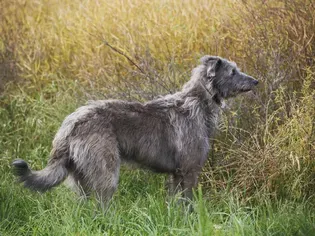Scottish Deerhound: Dog Breed Characteristics & Care
Updated on 05/27/24

Embrace the Majestic Scottish Deerhound: A Comprehensive Guide to Breed Characteristics and Care
Introduction
Step into the realm of grace and nobility with the Scottish Deerhound, an ancient breed renowned for its statuesque appearance, gentle nature, and unwavering loyalty. This guide will delve into the captivating world of these canine companions, exploring their defining characteristics, essential care requirements, and captivating history.
Breed Characteristics
Physical Traits:
* Towering Height: Reaching an average height of 28-32 inches at the shoulder, the Scottish Deerhound is a striking sight, commanding attention with its statuesque stature.
* Slender Build: Despite its size, the Deerhound is lean and athletic, boasting a graceful silhouette that effortlessly glides across the terrain.
* Silky Coat: Its double coat, featuring a soft undercoat and a wiry outer layer, comes in various shades of gray, blue, brindle, or yellow.
Temperament Traits:
* Gentle and Affable: The Scottish Deerhound possesses a gentle and affectionate nature, forming strong bonds with its family. Its sensitivity makes it an empathetic companion, attuned to its owner's emotions.
* Loyal and Protective: Despite its gentle demeanor, the Deerhound is also fiercely loyal and protective of its loved ones, always standing ready to defend.
* Independent and Dignified: The Deerhound retains an air of independence and dignity, carrying itself with a quiet confidence that belies its strength.
Health and Care
Lifespan and Common Health Concerns:
* Lifespan: Scottish Deerhounds have a life expectancy of 8-11 years.
* Health Concerns: Some common health issues include osteosarcoma (bone cancer), dilated cardiomyopathy (heart disease), and bloat (gastric dilatation-volvulus).
Essential Care:
* Nutrition: Provide a high-quality, balanced diet that meets the breed's unique nutritional needs and supports its active lifestyle.
* Exercise: Daily exercise is crucial for the Scottish Deerhound's physical and mental well-being. Long walks, runs, or frolics in open spaces are recommended.
* Grooming: Regular brushing is necessary to maintain the Deerhound's silky coat. Bathe as needed, taking care to use gentle shampoos specifically formulated for dogs.
* Veterinary Care: Routine veterinary check-ups and vaccinations are essential to ensure the optimal health and well-being of your Scottish Deerhound.
Training and Enrichment
Training:
* Positive Reinforcement: Start training early using positive reinforcement methods, such as treats or praise, to encourage desirable behaviors.
* Gentleness and Patience: Be gentle and patient while training your Deerhound, respecting their independent nature.
* Socialization: Early socialization is crucial to help your Deerhound develop confidence and interact appropriately with other people and animals.
Enrichment:
* Mental Stimulation: Provide your Deerhound with interactive toys and puzzle feeders to stimulate their minds and prevent boredom.
* Physical Activity: Engage in regular fetch games, chase, or other physical activities to keep your Deerhound active and satisfied.
* Companionship: Scottish Deerhounds thrive in companionship, so provide them with plenty of love, attention, and social interaction.
History and Origin
The Scottish Deerhound's origins can be traced back to the ancient Celtic tribes of Scotland, where it was used to hunt deer and other large game. Its size, speed, and endurance made it an invaluable asset in the rugged Scottish Highlands.
Throughout history, the Scottish Deerhound has been admired for its beauty, grace, and loyalty. It has been a favored companion of royalty and nobles, including Queen Victoria and the Duke of Argyll. The breed has also been depicted in famous paintings and literature, immortalizing its elegance and spirit.
Choosing a Scottish Deerhound
If you are considering welcoming a Scottish Deerhound into your life, it is essential to do thorough research and find a reputable breeder. Look for breeders who prioritize the health and well-being of their dogs and provide thorough health screenings.
Be prepared to provide a loving and supportive home where your Deerhound can thrive. Their gentle nature and sensitivity require owners who are patient, affectionate, and committed to their well-being.
Conclusion
The Scottish Deerhound is a captivating breed that embodies grace, loyalty, and dignity. Its striking appearance, gentle temperament, and unwavering companionship make it an exceptional choice for those seeking a noble and affectionate companion. By understanding their unique characteristics and providing them with proper care, training, and enrichment, you can embark on an extraordinary journey with your beloved Scottish Deerhound.
Explore More Pets

Basic Training
Puppy and Baby Introductions

Working Dog Breeds
All About Search and Rescue Dogs

Dog Treatments
Puppy Vaginitis: Signs, Causes and Treatment

Dog Adoption
After More Than 1,200 Days in the Shelter, Coco Goes Home

Basic Training
How to Train Your Puppy to Go on Potty Pads

Hybrid Dog Breeds
The Difference Between a Mutt, Mixed Breed, or Designer Dog?

Dog Treatments
Nail Problems in Dogs

Puppies
7 Reasons Why Two Dogs Are Better Than One
